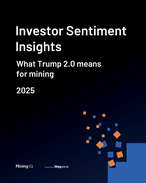This section reflects on the type of technical information that is expected to be available to support the various forms of funding available to mineral developers from the mining finance community. There is broad acknowledgement that the nature of the technical information available largely follows the development status of the mineral assets, and accordingly is largely independent of the nature of funding/financing options pursued.
To this extent, this section largely differentiates on the type of funding sought and how the level of technical information available is incorporated into various key supporting documentation required for the funding process.
As discussed in the previous section, sustainability has become a key factor influencing capital allocation. Financial institutions are assigning much weight to ESG in decisions relating to funding. Preference is being given to projects and operations that have negligible permitting and compliance risks. Coupled with this, the holding company is expected to be committed to sustainable corporate governance, be honest and clear about their ESG risks, and to show they have a way forward to address the risks.
Debt financing
Debt financing is largely available to mineral properties, which have attained the most advanced stages of project development; specifically, development properties and operating mines, which encompass both greenfield projects and brownfields expansions. The finance facility provided is typically underpinned by the projected future cashflows supported by a FS and ESIA or detailed life-of-mine plan for a development property or operating mine respectively.
For development properties, the supporting feasibility studies are generally required to conform with ‘bankable standards'. Similarly, the ESIAs and environmental and social management systems (ESMS) are required to conform with international ESG standards specified by the development financiers. Best known among the latter standards are the IFC Performance Standards. Development financiers may however apply numerous additional standards.
A further consideration is the typical requirement by the lenders to mandate specific advisors to complete due diligence in support of the funding decision. Typically this requires the developer (also referred to as the ‘sponsor') to facilitate the appointment of an Independent Engineer (IE) whose responsibility is to both verify and validate the underlying technical and economic assumptions included in the FS and reflected in a base case sponsor's financial model.
This process typically culminates in the authoring of an Independent Engineers' Report (IER) and establishment of a base case lender's financial model following the inclusion of appropriate adjustments and modifications as deemed appropriate.
A further key consideration is the identification of conditions precedent (high risk of occurrence and impact on economic performance) and conditions subsequent (generally required in respect of compliance and reflecting limited economic impact), which may be reflected as technical considerations in the ‘term sheet' that forms the basis of any project finance facility provided to the sponsor.
The IER, the lender's base case financial model and inter alia the term sheet is then provided as the basis for submission to the lender's credit committee which adjudicates in respect of the provision of the financing facility. This base case financial model is also tested with respect to key financing criteria including:
- Cash-flow available for debt-service (CADS)
- Debt service cover ratios (DSCR) - the ratio of cash available for debt servicing to interest, principal and lease payments in any given period
- Loan-life cover ratios (LLCR) - net present value of cash flow available for debt service (CFADS) which is measured up to the maturity of the debt tranche and provides an estimate of the credit quality of the project from a lender's perspective
- Reserve life (tail) cover ratios (RTCR) - the ratio of the saleable product and/or commodity reported in the ore reserves remaining to be mined at the scheduled maturity of the facility to the total metal saleable product and/or commodity reported in the ore reserve statement.
Collectively these are also referred to as financial covenants, which are generally integrated into the term sheet and form the basis for which the project may be considered to be in default under specific scenarios.
Following financial completion, processes are established for on-going monitoring whereby the IE is required to monitor (through physical inspection and desk top reviews) the performance of the project through final engineering design, construction, physical completion, start-up and attainment of name-plate capacity.
An additional aspect is the requirement for the IE to provide completion certificates at specified milestones - notably mechanical completion certificates, production completion certificates and economic completion certificates. The latter two certificates are typically provided following attainment of continuous operations over a defined period whereby pre-defined targets are met, be this production, metallurgical recoveries, unit cash costs of production etc. The satisfaction of the completion test may trigger a step down in interest rates, release of the project sponsor from its guarantee and other obligations and entitle the borrower to make certain permitted payments.

Image: iStock/Thomas_Zsebok
Equity financing
In order to access the equity capital markets, various international stock exchanges have incorporated within the relevant listing requirements, rules and guidelines pertaining to the publication of technical documentation, termed Competent Persons' Reports. These range from those which are mandatory, prescriptive and compulsory in nature such as the NI 43-101 Technical Report (required by Canadian securities commissions) to general guidelines established by the European Securities and Markets Authority (ESMA) and adopted by all European stock exchanges.
Similar general guidelines to that developed by ESMA are also in place for the Johannesburg Stock Exchange, the Hong Kong Stock Exchange and others, notably that recently adopted by the Australian Securities Exchange.
The requirement to produce such a report is generally triggered by a significant event, such as initial public offering, private placement, acquisition, merger or release of significant technical information to the market. Regulatory authorities may also, in certain instances, assess transactions by a materiality test, relating the value of that proposed to market capitalisation or percentage increase in mineral resource and ore reserve declaration. The results of such an assessment, including consideration for the class of investor (qualified buyers or public offering), assist in deciding the required documentation.
A further consideration is the requirement for certain exchanges to insist that the authors of such reports are independent of the issuer, and to this end tests are also normally applied to assess independence.
Whilst not always the case independence, has however, become on-market practice with respect to prospectuses and offering circulars.
Certain securities commissions and stock exchanges appoint independent technical readers to assess the quality and compliance of technical documents as part of the regulatory review process. In the case of Canadian securities commissions, the regulator may in certain instances periodically review submissions subsequent to disclosure; however, this is generally limited to the release of significant technical information to the market as opposed to transactions requiring shareholder approval.
Guidance regarding the technical content of such reports ranges significantly. It is important to note that whilst the mineral resource and ore reserve reporting standards are embodied within the listing requirements, these standards generally do not make explicit reference to any requirement for detailed reports and therefore, the relevant authorities have sought to define these separately and typically comprise:
- Mineral resource and ore reserve statements, reported in accordance with the pre-defined standards
- Detailed descriptions by discipline of the mineral assets comprising technical, economic and legal narrative which support the current development stage of the property
- Mineral asset valuations reported in accordance with the pre-defined standards
- For exploration properties, detailed exploration programmes comprising activity and expenditure schedules which render the mineral asset under consideration a ‘property of merit'.
For certain stock exchanges, the regulatory authorities specify instances where an independent opinion expressed through a ‘fair' and ‘reasonable' test is a mandatory requirement - as exemplified by the role of the Independent Expert (authored by licensed financial advisors) and the Specialist Technical Reports (authored by Competent Persons) on the Australian Securities Exchange.
The ultimate purpose here is to translate the ‘technical value' defined by the Competent Person to a ‘market value' determined by a recognised expert and often expressed as a value per share. This is then compared with that proposed by the company which forms the basis of the fair and reasonable opinion.

Image: iStock/Dragunov1981
1 Generally, the ESIA legislation in most countries uses the term "environmental impact assessment (EIA)", with the word ‘environment' referring to the social, physical, and biological surroundings of the project. International standards have added the word ‘social' to the term "EIA", creating the term "ESIA", because the social dimension was often neglected by EIA practitioners and regulatory authorities in the past
Explore the full Mining Journal Intelligence Global Finance Report 2022
Technical Glossary
MINING JOURNAL GLOBAL FINANCE REPORT 2022
Technical Glossary: Technical study standards
This chapter is authored by leading global mining expert, SRK Consulting
MINING JOURNAL GLOBAL FINANCE REPORT 2022
Technical Glossary: Mineral asset valuation standards
This chapter is authored by leading global mining expert, SRK Consulting
MINING JOURNAL GLOBAL FINANCE REPORT 2022
Technical Glossary: Permitting and Sustainability
This chapter is authored by leading global mining expert, SRK Consulting
MINING JOURNAL GLOBAL FINANCE REPORT 2022
Technical Glossary: Funding options: technical expectations
This chapter is authored by leading global mining expert, SRK Consulting
MINING JOURNAL GLOBAL FINANCE REPORT 2022
Technical Glossary: Mineral Resources and Ore Reserve reporting standards
This chapter is authored by leading global mining expert, SRK Consulting



























